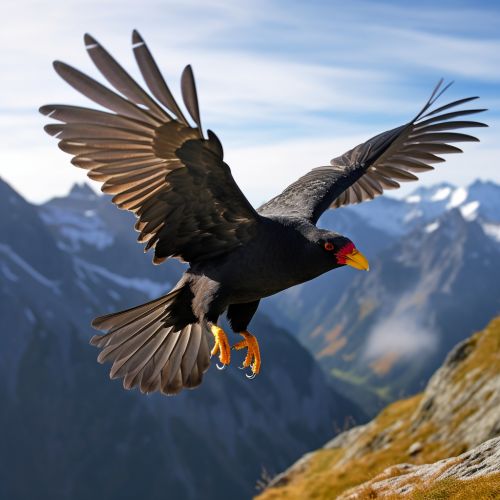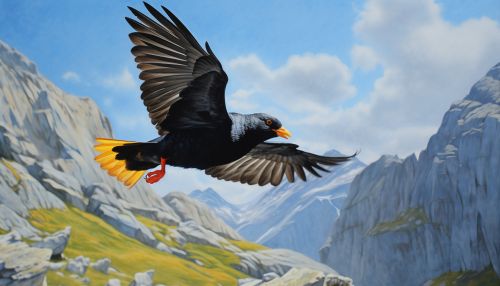Alpine chough
Taxonomy and etymology
The Alpine chough, or yellow-billed chough, is a bird in the crow family, scientifically known as Pyrrhocorax graculus. The genus name, Pyrrhocorax, is derived from Ancient Greek purrokorax, meaning "fire-raven". This is likely a reference to the bird's bright yellow bill, which contrasts with its dark plumage. The species name, graculus, is Latin for a jackdaw, a bird with similar appearance and behavior.
Description
The Alpine chough is a medium-sized bird, measuring 37–39 cm in length with a 75–85 cm wingspan. It is distinguishable by its yellow bill and red legs, which contrast with its glossy black plumage. The bird's flight feathers are broad and rounded, with the wingtips and tail showing a slight gloss of green and purple in sunlight. The Alpine chough's eyes are dark brown, almost black, and its bill is slightly curved downward.


Distribution and habitat
The Alpine chough is widely distributed across high mountain ranges of southern Europe, the Alps, the Pyrenees, the Caucasus, and parts of Asia, including the Himalayas. It is a high-altitude species, typically found above 2,000 meters, but can descend to lower altitudes in winter. The bird prefers rocky areas with plenty of crevices and caves for nesting and roosting. It is also commonly found near human habitation, particularly ski resorts, where it scavenges for food.
Behaviour
Diet
The Alpine chough has a varied diet, feeding on a wide range of food items. It is omnivorous, consuming invertebrates, small mammals, seeds, berries, and carrion. The bird is also known to scavenge from human sources, particularly in tourist areas where food is readily available.
Breeding
The Alpine chough breeds in colonies, with pairs forming long-term monogamous bonds. The breeding season typically begins in May, with the female laying 3-5 eggs in a nest built in a rock crevice or cave. Both parents share in incubation duties, which last around 17-18 days. The chicks are fed by both parents and fledge after about 31-41 days.
Conservation
The Alpine chough is currently classified as Least Concern by the IUCN. Despite facing threats from habitat loss and climate change, the species has a large, stable population and a wide distribution range. Conservation efforts are focused on protecting the bird's alpine habitat and minimizing human disturbance.
Cultural significance
The Alpine chough has been featured in various forms of human culture, from folklore and mythology to literature and art. In some alpine regions, the bird is considered a good omen and a symbol of the mountains. It has also been used as a mascot for various alpine clubs and organizations.
